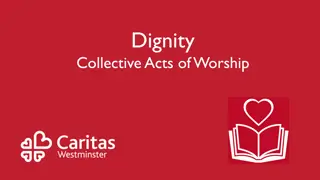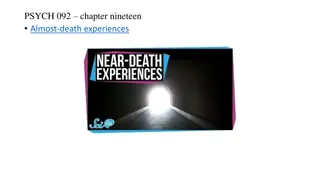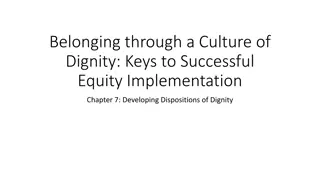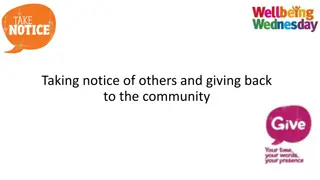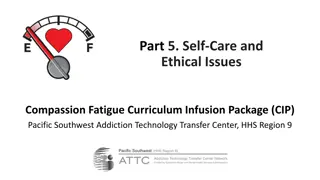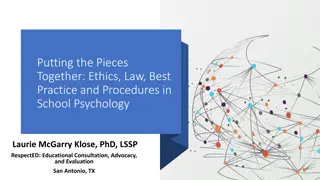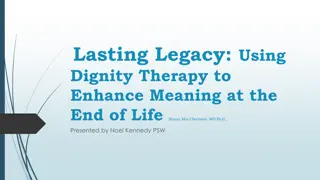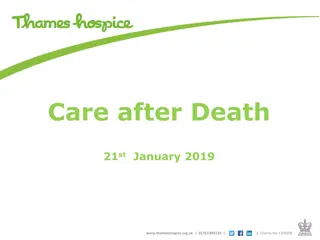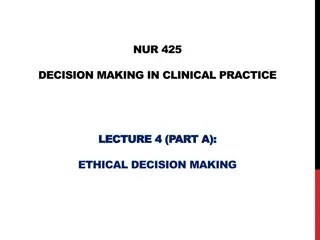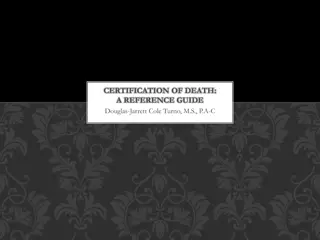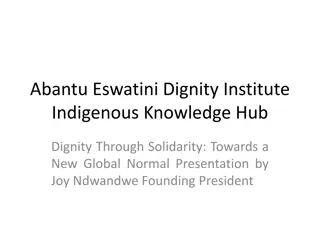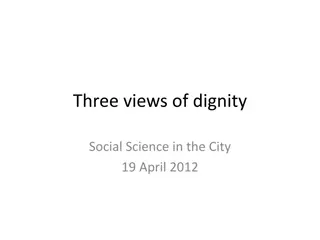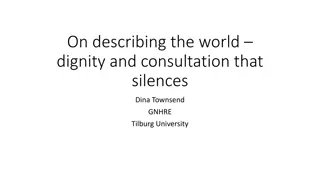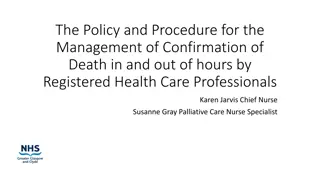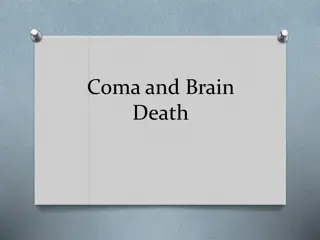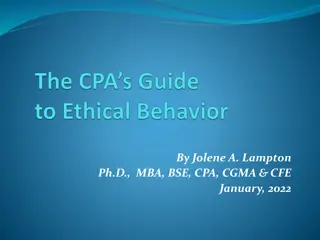
Ethical Considerations in Death with Dignity Discussions
Explore the ethical principles and values surrounding Death with Dignity (DWD) as discussed by Karen Smith, LCSW, Ph.D., at the Kansas City Funeral Consumers Alliance Annual Meeting. Topics include autonomy, beneficence, non-maleficence, and the rights of decisional adults in end-of-life care decisions. Learn how these principles shape discussions on DWD and aid in dying, emphasizing the importance of respecting individual choices and values.
Download Presentation

Please find below an Image/Link to download the presentation.
The content on the website is provided AS IS for your information and personal use only. It may not be sold, licensed, or shared on other websites without obtaining consent from the author. If you encounter any issues during the download, it is possible that the publisher has removed the file from their server.
You are allowed to download the files provided on this website for personal or commercial use, subject to the condition that they are used lawfully. All files are the property of their respective owners.
The content on the website is provided AS IS for your information and personal use only. It may not be sold, licensed, or shared on other websites without obtaining consent from the author.
E N D
Presentation Transcript
Death with Dignity: Ethical Considerations Kansas City Funeral Consumers Alliance Annual Meeting November 3, 2017 Karen Smith, LCSW, Ph.D Clinical Ethicist
Introduction Welcome to the most fun you ll ever have talking about death & dying. The ethical principles involved in DWD Aid in Dying restrictions; the details count How to get the death you want is more than just talking about Advance Directives
Philippe Aries : The chasm between the discussion of death in books, which is still prolific, and actual death, which is shameful and not to be talked about, is one of the strange but significant signs of our times.
What are we talking about? Principles DWD Concepts & Values Rights
Accepted Ethical Principles Autonomy Reigns Supreme A person may forgo extraordinary or disproportionate means of preserving life. Disproportionate means are those that in the patient s judgment do not offer a reasonable hope of benefit or entail an excessive burden, or impose excessive expense on the family or the community. The free & informed judgment made by a competent adult patient concerning the use or withdrawal of life-sustaining procedures should always be respected & normally complied with, unless it is contrary to specific religious or moral teaching.
Accepted Ethical Principles Professional Obligations Beneficence- of medical providers to have patient interests at heart in all efforts to provide cures, treatments and relief of suffering such that the patient is benefitted from those efforts. Non- Maleficence reduction of any patient harm or suffering wherever it is possible, elimination of preventable harms.
Rights restricted to Decisional Adults Decisional Adults have the right to consent or refuse to consent to treatment or medical procedures Decision making capacity may be defined as an ability to receive and evaluate information effectively, in accordance with one s own value system and to make and communicate decisions Mental incapacity is not limited to those declared mentally incompetent
Rights to Refuse Treatment but NO Right to Demand Treatments Competent adult patients can consent to or refuse procedures and/or medical treatment Cruzan v. Missouri Dept. of Health, 497 U.S. 261 (1990) U.S. Supreme Court held that under the Due Process Clause, a patient has a constitutionally protected liberty interest in refusing treatment NO corresponding right to Demand treatments which are not considered medically appropriate or necessary. The Texas law was tested in March 2005 when Sun Hudson, born with thanatophoric dysplasis, a typically fatal form of congenital dwarfism, was removed from a breathing tube against the wishes of his mother, Wanda Hudson. The breathing tube was removed pursuant to Chapter 166 of the Texas Health and Safety Code, the Advance Directive Act [9].
Refusal of Treatment is Durable (in most cases) May request withdrawal of life sustaining treatment including vent support, artificial nutrition and hydration or dialysis May also consent to a DNAR order whereby resuscitation will not be performed Consent, once given, is the patient s to withdraw. Family or physicians may not override a patient s own DNAR
Why doctors provide non-beneficial tx Although providing these treatments can compromise physicians' professional integrity, many feel compelled to comply with the patient's or surrogate's wishes because they believe that society has mandated the provision of such interventions unless there is an agreement to withhold them. Fear of litigation . Let s be honest it drives WAY too much of health care and death care It s easier than having difficult often repeated discussions with families.
Ethical Dilemma Prolonging Death vs. Allowing to Die MORALLY CORRECT ACTION: ??? LEGALLY REQUIRED ACTION:???
The Cautionary Tale of Judy Dale Judy's oncologist at UCSF informed Judy in May 2016 that she had incurable, Stage IV metastatic colorectal cancer. The EOLOA became effective in June 2016, shortly after Judy received the news that she had incurable, terminal colorectal cancer. Judy talked openly and frequently to her health care providers at UCSF about her desire and intention to choose a more peaceful death through aid in dying. On August 18, 2016 a UCSF social worker told Judy that a decision had been made that none of her UCSF doctors would provide aid in dying. Judy began a frantic search for a physician who would be willing to help her. On August 29, she made contact with such a physician and had an initial visit with him on August 31, transferring her care and starting the clock running on the 15 day waiting period required by the EOLOA. Every day until her death Judy would ask her daughters if it was the day she could obtain the aid in dying medication. On the day before the end of the waiting period, Judy died, precisely how she feared and planned to avoid, in bed, in a diaper, bleeding from her rectum and urinary tract and too confused by powerful pain medications to say goodbye.
The legacy of Judy Dale we hope "This case is brought to serve the public interest and make clear the duty of medical providers who choose to opt out of providing aid in dying (as allowed by the EOLOA) to inform their patients in a timely fashion. It is not acceptable for health care providers to mislead a patient into believing that their wish for aid in dying will be respected and the care forthcoming, and then, late in the patient's demise, to disclose that this option will not in fact be provided." said Kathryn Stebner.
Aid in Dying: Not for Sissys! Many Requirements to follow .. PATIENT MUST Terminal prognosis - <6 mos Difficult to predict in many illnesses such as dementia, some cancers, also not available for some diseases such as drug abuse Must have decision making capacity If concerns must have second eval from mental health specialist Must have physical & mental ability to self- administer meds Leaves out many with ALS, Dementia or other progressive physical or mental disability. 3 Voluntary separate requests 2 Oral requests made at least 15 days apart 1 written request using statutory forms ATTENDING PHYSICIAN MUST Certify that patient has terminal <6 month dx Refer to patient to an independent, consulting physician to confirm diagnosis, prognosis, capacity and informed decision making. Counsel the patient in the presence of another person about when the med is taken, no public place, notification of NOK of patient decision, participation in hospice, safekeeping and disposal of meds. Completion of mandatory state forms Request patient to complete the attestation form no more than 48 hrs prior to medication ingestion. (Pt s are not required to follow MD requests).
Some fine points not clearly addressed Patients can opt out at any time ~ but what if they decide they want back in ? Do they have to start at the beginning again? Can they pick up where they left off? Who can be the attending physician? Attending is usually for hospitalized in patients, while most with AID are outpatients with a PCP, specialists, and possibly palliative care doctors all involved in care. Who has priority? If they are all involved who would be an independent consultant ? What if a patient s capacity was fine during first request, and maybe second but then declined by the 3rdwritten request? Could they write letter in advance and hold to give you later if they suspected this might happen? What counts as able to take medication independently? Just hold straw? Just sip from straw?
Stats from the First Year of End of Life Options Act (EOLOA) in California From June 9, 2016 through December 31, 2016, 258 individuals started the end-of-life option process, as set forth in the Act, by making two verbal requests to their physicians at least 15 days apart. 173 unique physicians prescribed 191 individuals aid-in-dying drugs. Of the 191 individuals who were prescribed such drugs, 111, or 58.1 percent, were reported by their physician to have died following ingestion of aid-in-dying drugs prescribed under EOLA; and 21 individuals, or 11.0 percent, died without ingestion of the prescribed aid-in-dying drug(s). The outcome of the remaining 59 individuals, or 30.9 percent, who have been prescribed aid-in-dying drugs, is currently undetermined as there has been no outcome reported for these individuals within the time period covered by this report. A chart illustrating the outcomes is provided on the next page as Figure 1. www.cdph.ca.gov/Programs/CHSI/Pag es/End-of-Life-Option-Act-.aspx
www.cdph.ca.gov/Programs/CHSI/Pag es/End-of-Life-Option-Act-.aspx
Why doctors dont want to provide Aide in Dying Practical Reasons Complying with the law requires physicians follow extensive legal guidelines and have conversations with patients that are often difficult. "It raises a lot of feelings on the part of the doctor," says Wenger. "It is something very, very different than what a doctor does which is saving people . And it's complicated. It takes a whole lot of time. Fear of litigation It s easier to say No", than having difficult often repeated discussions with patient s and families Against personal religious or moral beliefs
Why doctors dont want to provide Aid in Dying Historical Reasons the Hippocratic oath states, I will not administer poison to anyone when asked to do so, nor suggest such a course. The American Medical Association, the nation s largest association of doctors, has been formally opposed to the practice for 23 years. Its ethical and judicial council has recently begun to study the issue further.
Why doctors dont want to provide Aide in Dying Ethical Reasons Goes against Beneficence - a physicians role is to do good, to heal, to cure and to fight against death in ways that only the physician can. We trust them to cut out cancers, to repair or replace damaged organs, to offer poisons to kill off invisible invaders of our health. They fight AGAINST death not for her. Goes against Non-maleficence - assisting in dying seems like doing harm.
Dr. Shavelson : 1 doc in CA and his practice changes since EOLOA Should I Help My Patients Die? Posted on August 7, 2017 by Richard Wagner He does not offer the medications to most of the patients who request them, sometimes because he deems them more than six months away from death or because he is worried that they have been coerced or because he believes that severe depression is interfering with their judgment. Since starting his practice, he has been approached by 398 patients. He has accepted 79 of those into his program and overseen ingestion and death for 48. While all patients enter a coma within minutes of ingesting the lethal cocktail, some deaths take longer, which can be distressing for the family and everyone else involved. One of his patients, a serious athlete, experienced a protracted death that Dr. Shavelson attributes to the patient s high cardiac function. In another patient, a mesh stent had been deployed to keep his intestines from collapsing. This stent prevented absorption in key areas, slowing the effect of the drugs and prolonging his death.
A doctors evaluation of the new law My patient deserved an evaluation by a physician like Dr. Shavelson, not someone like me, with no training in this area and ambivalence to boot. We need formal protocols, official procedures, outcome measurements, even a certificate of expertise issued by an oversight board. None of these are in place in any participating state, according to Dr. Shavelson. Yet all medical procedures require training. Why should one this weighty be an exception? What about payment? Providers can bill for an office visit and the cost of the medication. But because there are no specific codes established for this procedure, reimbursement doesn t come close to covering any effort to do this well. On top of that, many insurers won t cover it, including federal programs like Medicare and the Veterans Health Administration.
Why we want Aid in Dying Is medical aid in dying a reductive response to a highly complex problem? The over-mechanization of dying in America has created a public health crisis. People feel out of control around death. A life- ending concoction at the bedside can lend a sense of autonomy at a tremendously vulnerable time. Unlike medical aid in dying, which will be used by a small proportion of the population, palliative interventions can improve the lives of many. Most patients aren t seen by a palliative care physician before they make this request. Although recommended, it isn t required by law. And yet palliative input gives another option.
Euthanasia and Aid in Dying is not a new concept In 1870, Samuel Williams, a Birmingham businessman and amateur philosopher, proposed a more definitive form of this new medical treatment for the terminally ill. In an essay called Euthanasia, published by the local Speculative Club, he wrote: That in all cases of hopeless and painful illness, it should be the recognized duty of the medical attendant, whenever so desired by the patient, to administer chloroform or such other anaesthetic as may by-and-by supersede chloroform so as to destroy the consciousness at once, and put the sufferer to a quick and painless death.
A chance to get the lead .in the 1800 s Custom prescribed that death was to be marked by a ritual ceremony in which the priest would have his place, but only as one of many participants. The leading role went to the dying man himself. He presided over the affair, with hardly a misstep, for he knew how conduct himself, having previously witnessed so many similar scenes. He called to him, one-by-one his relatives and servants ..he said farewell to them, asked and gave forgiveness and blessings. P. Aries
Ugly little truths.. At the time of death 3/4 are non- ambulatory, 1/3 incontinent, 40% cognitively impaired. Initiating End-of-Life Discussions with seriously Ill Patients- Timothy Quill,MD. JAMA nov. 15, 2000 Vol 284, No. 19 pg 2502-2507
We all say, of course, that we would rather die surrounded by friends and family. But behind this wish is usually another, more often unspoken , that we should die in a decent manner, preferably well-dressed, make-up unsmeared, face undistorted by pain or unbroken by violence, still pink and flushed and untainted by anything quite so offensive as blood. pg. 173Death and Philosophy Edited by Jeff Malpas and Robert C. Solomon pub. Routledge, London and New York, 1998.
Remember.. DWD is not for sissys! YOU need to have many discussions earlier than you think.
Why- Initiate End of Life Discussions Need to identify a single physician to coordinate and communicate the medical aspects of each patient s overall care Patient and family members should be able to answer the question Who is your main doctor? Designated physician should encourage full participation by the team, including nurses, social workers, pharmacists, clergy, designated family, etc.
Why- Initiate End of Life Discussions Patient allowed to work on life closure issues Life reflection & review (e.g., writing, recording memories, preparing letters for those too young to understand) Healing family/interpersonal relationships Healing spiritual relationships Completing will and distribution of assets
Why-Have End of Life Discussion Early? Initiating discussions earlier and more systematically Improves patient ability to make more informed choices Improves palliation of symptoms for patient Offers patients opportunities to work on issues of life closure
Who - Will Initiate End of Life Discussions Typically rely on physicians to initiate Perhaps this needs to be changed? Challenges No long term relationship with a physician Changes in health care settings Institutionally based physicians Fragmentation of physicians over the continuum of care
How- Should End of Life Discussions be Broached Explore patient s recent quality of life Outside the hospital (i.e., home or other settings) Explore patient s concerns about quality of life Conduct a values history What makes life worth living for the patient? What circumstances make it not worth living?
How Should End of Life Discussions be Broached Prognosis Acknowledge range of time periods (i.e., minutes to hours, days to weeks, months to years) Acknowledge possibility of exceptions/changes Don t shy away from making recommendations, offering guidance
How - Should End of Life Discussions be Broached Physician awareness of patient s cultural, ethnic and religious background Address difficult questions Not always necessary to provide answers An honest, compassionate response
What - Should be Included in End of Life Discussions Patient s goals, values and wishes Patient s perspective on prolonging life versus enhancing quality of life Avoiding overtreatment Maintaining personal control Range of prospective specific interventions, e.g., CPR, intubation, use of escalating doses of morphine, etc. Use of comfort care measures
Conclusion: Why We Do What We Do Physician/Care Provider needs: Intimate end of life decision making can be emotionally enriching and psychologically draining Assures solidarity of the physician-patient relationship Share uncertainties regarding treatment options with colleagues and the team Utilize team to discuss personal reactions and receive support
Conclusion: Why We Do What We Do Providing the best quality of care includes discussions re End of Life decision making Allows patients to achieve a good and meaningful death
Conclusion What are the barriers to DWD? Physician? Patient? Family? What about your experience now and what might change? EVERYTHING might change .
How to get the Death You Want! Think, really think, about what it would be Acknowledge which potential trajectory is likely Make clear Advance Directives and SHARE THEM!! Talk with your family about your wishes (in the end others are likely to be making decisions, so they are only wishes) Realize that you will need to start accepting less care earlier than you think in order to get the death that you say you want.
Make DEMANDS on family & friends Go ahead! They did it all the time in years past, let them know How important it is to have them near Back to pre-K use your words ..they aren t mind readers OK, maybe send a letter or email but do it! Have REAL conversations, share your fears, concerns, hopes. You will likely be pleasantly surprised that it will be easier than you think once you get started. Ask for help, after all, we re only human.
Citations Initiating End-of-Life Discussions With Seriously Ill Patients: Addressing the Elephant in the Room Timothy E. Quill,JAMA. 2000;284(19):2502-2507 http:jama-ama-assn.org/cgi/content/full/284/19/2502 The Hour of Our Death: The Classic History of Western Attitudes Toward Death Over the Last One Thousand Years , by Philippe Aries. Second Vintage Books Ed 2008. Copy Right 1981 Alfred Knopf, Inc. Implementing California s Law on Assisted Dying HASTINGS CENTER REPORT ,March-April 2017 and personal conversation with Ruchika Mishra, Ph.D. Should I Help My Patients Die? Posted on August 7, 2017 by Richard Wagner UCSF sued for refusing to help woman die by TRACY SEIPEL | tseipel@bayareanewsgroup.com | Bay Area News Group PUBLISHED: July 17, 2017 at 9:20 am San Jose Mercury News| UPDATED: July 19, 2017 at 5:51 pm
We Need Your Support Please support BOTH Your local FCA ( and like us on FB) Our National FCA www.funerals.org Like Ethics Chick on FB


